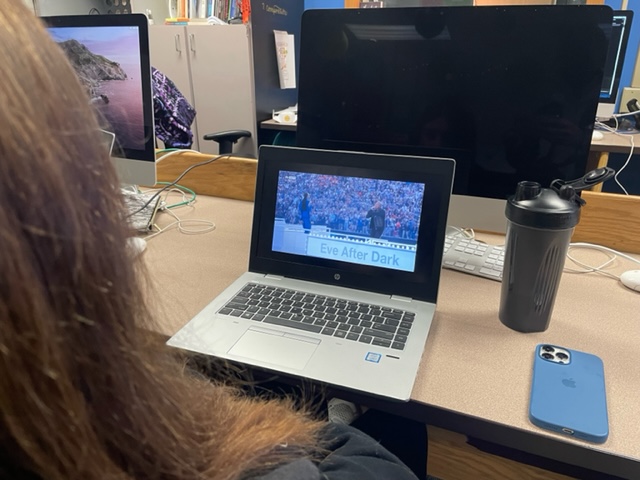On September 21, the Curriculum and Instruction committee and principal Tom Chambers met to discuss possible schedule changes.
“I think it went well; I presented the information that we have so far on different types of schedules, and they want to get some more information on that,” said Chambers. “We will be interviewing and talking with a number of schools that have different schedules to get more information.”
The school has now set a timeline for making this decision; the school board will decide in February. The administration has many points to consider in the meantime.
“It’s hard to come up with real solid data to say that this particular schedule makes smart kids…there are so many factors in what makes a good learning environment,” said Chambers.
The main thing is to decide if a 45 or an 85 minute class is better for students.
“One of the things we’re looking at is to see if it’s better for a student to be in a class for 45 minutes, or is it better for them to be in class for 85 minutes. Where do they learn better?” said Chambers.
Another issue the administration has to consider is which classes will benefit from a a shorter class period, and which will benefit from a longer class period.
“Changing the schedule, whether its from a block to a seven or eight period day, that might help music classes because music wants to be 45 minutes,” said Chambers, “but it might create problems for Biology or Chemistry where they want to do bigger labs. It certainly would create problems for tech ed. when they want to go out to the house to build and they only have 45 minutes, and they have to drive for 5 or 10 minutes one way. ”
Other departments, like math and foreign language, would like to run all year long. Those departments would benefit from a 45-minute class length.
“By solving one problem we’re creating another problem, so we have to be really careful on how we make change, and why we make change,” said Chambers.
No matter how much thought the administration puts into this decision, not every scheduling conflict will be solved.
“You’re never going to solve all scheduling conflicts because you’re always going to have a certain number of teachers, a certain number of students and a certain number of courses you can offer. A student is never going to be able to take every single class that is offered. It’s physically impossible to be in two places at one time,” said Chambers.
But it’s not necessarily about solving every problem; it’s about creating a better learning environment for students.
“We want to do what’s best for the learning of the kids; it’s not what’s convenient for the teachers […] or even what’s most convenient for a kid’s schedule. It’s what’s most effective for their education,” said Chambers.





Kortney • Nov 8, 2010 at 11:50 am
I think that we should stay at what we are now! changing the block thing is just goning to ruin everything. we have thing set now and they are working great. the only reason our test scores are low is not becasue we have a four block day its because of the people who chose not to study or take time on to pay attention in school. They said we need to fix the problem of our scores being so low. Well i think we should find ways that we can get people to study or another method that will help them in school. Like Mr. Chambers said…. “We want to do what’s best for the learning of the kids; it’s not what’s convenient for the teachers […] or even what’s most convenient for a kid’s schedule. It’s what’s most effective for their education.” So who care if the music teacher only want 45 minutes for there class. We get more of a benifit in a 85 minute class then we would in a 45 munute class.
another reason is right now we olny have to focus on four classed not 7
D-Dog • Oct 21, 2010 at 8:23 am
As a freshman I didn’t know what to think of the block schedule and I may have hated it at first, but in the last 4 years I have fallen in love with block scheduling. It’s way more efficient with the classes that we take and we have less homework than we would have if it was shorter classes. Keep it the way it is, and kids will love learning…
AND THAT’S THE BOTTOM LINE CUZ D-DOG SAID SO!
Cassie Olson • Oct 18, 2010 at 8:17 am
I know this will not apply to me next year, but I have to agree with Lizzie. The block schedule is actually pretty solid, but it also has its faults. The block schedule is a good way for students who take upper-level classes (i.e. AP classes) to learn all of the information and have the time to work out problems in class. Having taken some AP myself, I understand the problems with the distance between semester one AP classes and the test in May. Being a band and choir student, I also understand the major issues that have arose in that area. This is why I agree with Lizzie: a mix of both block and 8-hour scheduling could eliminate such problems. Having the block option for some classes, and 8-hour splits for the other…basically what it is like now with skinnies, but with more options. As for AP classes facing tests in May, I am not sure if there is a reason against it, but couldn’t AP classes be at term 2/3 class?? It sounds kind of crazy, but it could work. Term three gets done in late March/early April, and the tests are in May. That would give classes the chance to study after the classes are over, but still have the information in their heads closer to the test. I understand, that is a far-fetched idea, but it would eliviate a couple issues.
Brittani • Oct 14, 2010 at 6:37 pm
i think the block schedule is good and it actually gives you time to learn, do work, and get the help you need from the teachers.
Cassie Zinns • Oct 14, 2010 at 9:56 am
I think it should stay the same. Sometimes I struggle with having homework in all four of my required classes every night-how would I manage 8 classes again? Block scheduling is another thing that makes high school better than middle school. Not gonna lie, I will be upset if things change.
Lizzie Cook • Oct 10, 2010 at 11:27 pm
I really love the block schedule. Though, I can see the benefits to having shorter classes. A solution for tech and science classes could be blocking hours. Like, if there are 8 periods in a day, hours 3 and 4 would be chemistry, instead of two different classes for each hour.
BSKELD • Oct 8, 2010 at 4:25 pm
I think it should stay the way it is, i don’t think anyone wants to balance 6-7 classes instead of 4. i know it won’t affect me but the block schedule is where it’s at. if only a couple classes need the change its not going to benefit the whole, no matter what you do there are going to be problems so the best thing is to keep it the way it is.